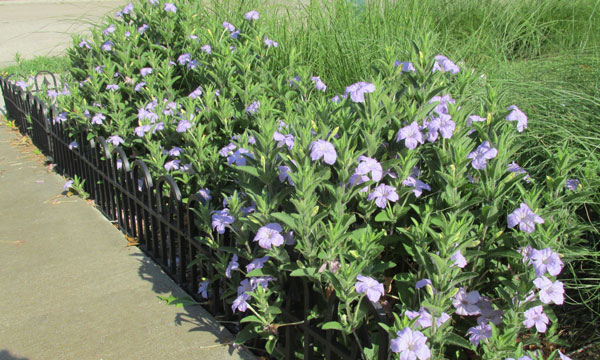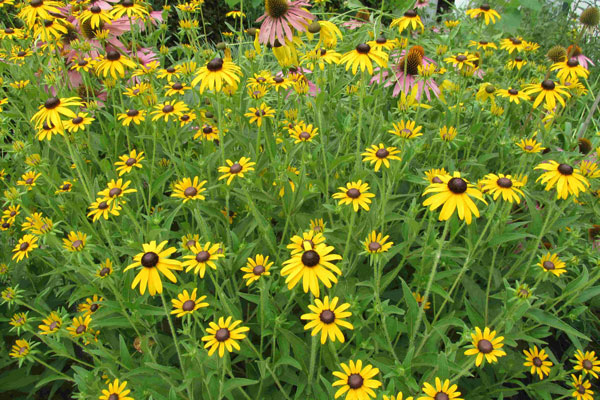

By Mitch Leachman,
Coordinator, St. Louis Open Yards
Native plants are simply plants that naturally occurred in an area prior to human settlement. Gardening with natives, instead of traditional ornamental non-native plants, seems straightforward. Fortunately, native plants are quite readily available these days, thanks to efforts like Grow Native! which generates public awareness of the value of native plants and encourages nurseries to carry them. Instead of buying annuals or spreading zinnia seeds each spring, introduce a variety of native perennial flowers that native pollinators and other creatures depend upon for survival.
The native plant selection process is often boiled down to right plant, right place. Simply match the desired plant to its required site conditions including sunlight, moisture needs and so on, and check that the mature size of the plant fits with your design aesthetic for that space. That’s just about it; now go!
Unfortunately, that misses a host of other factors including inter-plant competition, native “weed” volunteers, plants that spread vegetatively, self-seeding and more. Failing to incorporate these other factors when planning the garden can often lead to frustration with the results. Too often native gardens are begun again or abandoned altogether due largely to not planning for these “plant behaviors.”
To mulch or not to mulch. Traditional gardening often includes wide swaths of regularly applied mulch in-between plants, but that thick mat of ground up tree bark provides very little support for the food web. Instead, native plant gardeners urge the use of short, spreading ground cover plants as a “green mulch” in-between the showy, upright priority species such as Purple Coneflower, Butterfly Milkweed and such. Yet, it can take a while for the ground cover to get established, and it can be hard to know how many plants will effectively replace the bark mulch. Which leads to the money issue – having sufficient funds for all those wonderful plants.
That brings up the subject of competition between plants. With all the mulch in a traditional setting, plants are often kept apart. One plant species does not have the opportunity to dominate or overwhelm another. With or without a ground cover planting, native plant gardens frequently include mixed species arrangements – different plants side by side. This occurs naturally in the wild, and many gardeners want to emulate what they see in nature. Yet, in garden settings some plants more readily spread by seed or expand vegetatively than other species and can swamp species that are insufficiently aggressive. This can be disappointing of course but also expensive should you “lose” any of your plant species.
Whether thickly mulched or planted with soil-covering native ground covers, most any garden will produce native “weeds,” unintended plants introduced by the wind or wildlife. These will include goldenrod, violets, wood sorrel, tree seedlings and many more. Knowing they all have value and a role to play in the ecology of the landscape, it can be hard to remove them. Some fritillary butterfly species reproduce on the leaves of our native violets. Milkweed of course is the essential host plant for the Monarch butterfly. There may very well be eggs or tiny caterpillars of just such creatures on plants you want to clear from an area they were not intended. Not removing them will compromise your garden plan, and perhaps crowd out other desired plant species. Is it possible to clear some and leave others?
All of this points to the tremendous value of garden tours and gatherings in individual residential native plant landscapes, engaging directly with the creators of those gardens and learning of their own best practices. In April, the greater St. Louis region gained a new opportunity to do that in a very in-depth way through the St. Louis Open Yards program.
Currently Open Yards provides access to nearly 40 private native landscapes across the St. Louis region, from Washington and Union to Elsah and Edwardsville and many points in-between. Each yard is open on its own schedule from spring through fall. The website’s search engine helps you find a yard by date(s) available, yard features like shade or rain garden, or by location. The small registration fee for adults covers program expenses with all remaining revenue distributed to a network of 25 charities.
Gardening with native plants is full of inspiration and wonder, but it can also be frustrating. Visiting with other native plant enthusiasts in their own yards and learning of their journey, mistakes and best practices is one of the very best ways to avoid similar missteps. Knowing your St. Louis Open Yards registration fees also help support a variety of social causes is most certainly a bonus. Happy gardening and hope to see you “in the field!”
Mitch Leachman
Coordinator
St. Louis Open Yards
stlopenyards@gmail.com
314.599.7390
https://www.facebook.com/St-Louis-Open-Yards-101577945649955
Wild Petunia (Ruellia humilis) in spring (top) showing its aggressive self-seeding habit; the same species in bloom in mid-summer.
Showy Coneflower (Rudbeckia fulgida) in spring (bottom) spreading vegetatively and acting as a ground cover; the same in bloom late summer.


